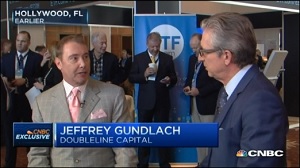By Pam Martens: January 28, 2015

Jeffrey Gundlach, DoubleLine CEO, Tells CNBC’s Bob Pisani What He Thinks the Fed Is Really Up To With Its Interest Rate Talk
The Federal Open Market Committee (FOMC) of the Federal Reserve will release its monetary policy statement at 2 p.m. today against a backdrop of extraordinary global events since its last statement on December 17. Since that time, deflationary forces have picked up steam in the 19-member Eurozone forcing the European Central Bank to announce a large scale quantitative easing program to buy up government bonds in the hope that the added liquidity will spike spending and inflation.
A political earthquake has also been unleashed by the Coalition of the Radical Left, known colloquially as Syriza, seating their candidate, Alexis Tsipras, as Prime Minister in Greece. The win came on a platform to end austerity and renegotiate the terms of the Greek bailout. This is causing spasms in stock and bond markets in Europe over concerns it could lead to Greece’s exit from the Euro or cause other debt-laden Eurozone members to ask for similar concessions.
Here at home, tremors have been picking up pace since the December FOMC meeting. Large corporations have been announcing big job cuts: American Express, 4000; Coca Cola, 1600 to 1800; IBM, at least 2000 with rumors suggesting the number is far higher; Schlumberger, 9000; Baker Hughes 7000; U.S. Steel 750.
Part of the downsizing problem is the global economic slowdown but another serious headwind for U.S. based multinational corporations is the strong U.S. dollar which has gained about 20 percent against other major currencies over the past eight months. A strong dollar hurts U.S. based multinationals’ earnings and can erode market share by making their products and services less competitively priced for consumers in foreign countries who are making their purchases in weaker currencies. U.S. companies which have already blamed the strong dollar for crimping earnings include Procter & Gamble, Pfizer, DuPont and Goodyear.
U.S. multinationals know they have the Fed to thank for the dollar’s strength. The Fed’s persistent chatter that it plans to raise interest rates later this year on the premise of improved economic conditions here at home has put a prop under the dollar and led much of the world to believe that the U.S. is back to its goldilocks economy – not too hot and not too cold. Neither Wall Street On Parade nor DoubleLine CEO Jeffrey Gundlach is buying that spin.
As we have previously noted, back on December 16, 2008, the FOMC correctly interpreted “declines in the prices of energy and other commodities” as a harbinger of “weaker prospects for economic activity.” Today, a 60 percent drop in oil prices in the span of seven months and sharp plunges in a broad range of other industrial commodities have incredibly failed to wake the Fed from its apparent stupor on what’s actually going on in the world. Unless, of course, the Fed is simply trying to reload its gun, as we suggested in October.
Yesterday, Jeffrey Gundlach added some weighty arguments to the above thesis in an interview with CNBC’s Bob Pisani during an investment conference in Hollywood, Florida. Gundlach had this to say:
Gundlach: “I think it’s obvious that the world is dealing with a deflationary situation. If you look at breakevens and TIPS versus the nominal market, across the globe, really. If you look at yield curves which flattened, across the globe, during 2014. And you look at PriceStats, the internet-based transaction of prices daily, it’s at zero year over year. If you look at the dollar strengthening, that’s deflationary. If you look at commodity prices collapsing, really to multi-year lows, you wonder what they’re [the Fed] thinking about raising interest rates.
“They say something contradictory. This is part of the gibberish. They say their mandate is stable prices but they define stable as rising two percent per year. Which, last time I checked, was not the definition of stable. But, anyway, their goal is two percent a year – you haven’t been at two percent a year in like forever – and it’s going the other way.
“So what is the logic for raising short term interest rates? I think the logic is that they don’t like having no tools. So that when and if the economy rolls over, if you’re at zero at that time, you’re in a very bad situation.”

